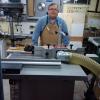I've done the requisite searches and can't seem to get my answer. So I'll ask!
My job moves me every few years whether I like it or not, and thus so does my shop. As a result, I'm renting my housing and shop is in the garage. I'd like to hang tool's and cabinets on my walls with a french cleat system, which I'm aware gets it's strength from quality screws in studs.
My vision is to have a 4 X 8 sheet of plywood with rows of cleats firmly affixed to it. That sheet is then affixed to my wall utilizing the studs. When it comes time to move, I take down the sheet(s) and put them back up in the new garage.
This is approach would allow me some consistency from one place to the next, and (perhaps more importantly) I wouldn't be putting as many holes in my rental walls.
The he bottom lune question is: Is the described solution strong enough or am I asking for trouble here? Thanks.
-Hunter




 Reply With Quote
Reply With Quote





